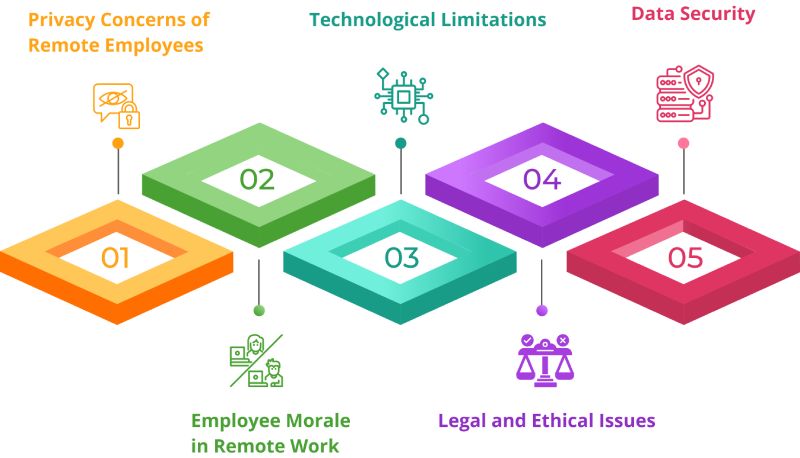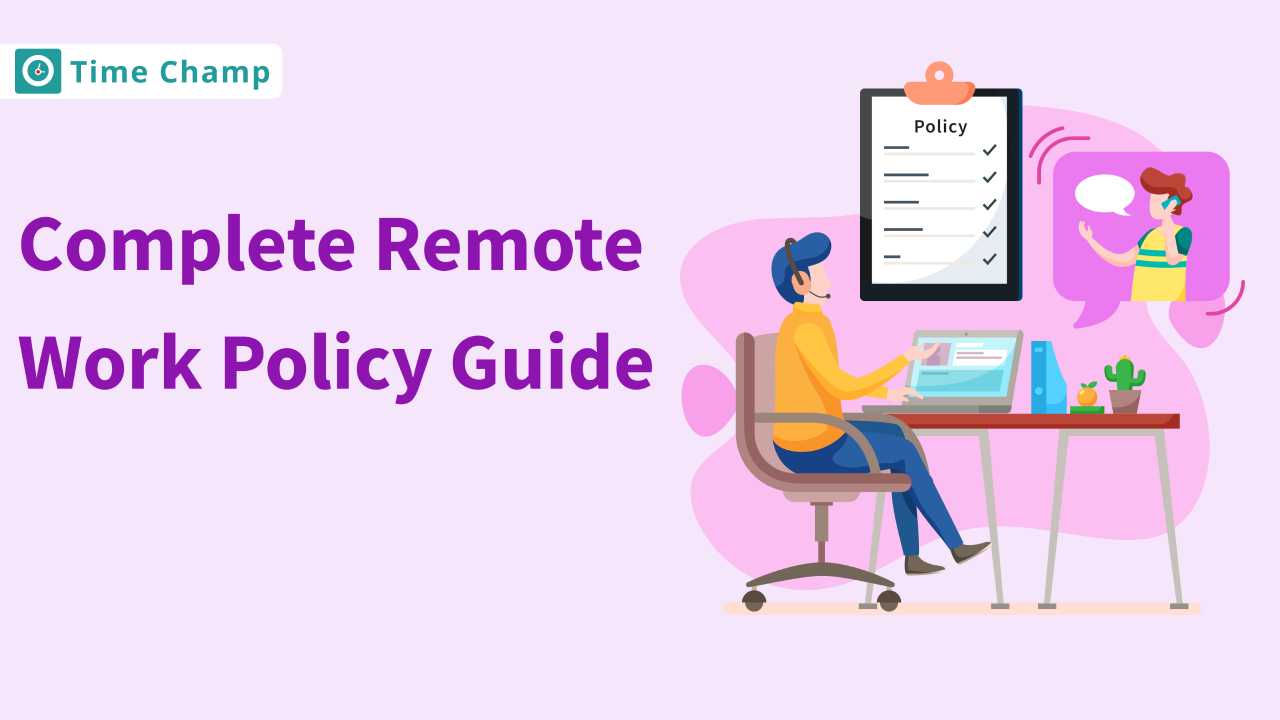Have you ever wondered how to monitor your remote employees without infringing on their rights? Monitoring employees who work from home may seem like a challenging task, but it isn’t. As the trend of working from home continues to grow, it is crucial to understand how to lead your team remotely. In this guide, you will learn how to monitor your remote employees and the advantages that are attached to it. Whether you’re new to managing remote teams or looking to refine your approach, this blog will provide you with practical tips and insights to keep your team productive, more engaged, and on track. Well, let’s discuss the specifics of how you can leverage remote employee monitoring.
Steps to Monitor Remote Employees:

To increase efficiency and ensure that the members of the remote team are in constant communication, it is necessary to introduce a structured remote monitoring system. Below are some steps you can take to ensure you manage and monitor your remote employees effectively.
1. Assess Budget for Remote Monitoring Tools
First, determine the amount of money that can be spent on the tools required for remote employee monitoring. Additionally, it is necessary to evaluate your budget to ensure that you invest in a worthy cause. Consider the number of people in your team and the functions you need, and then compare the tools to determine which one is cheaper.
2. Implement Remote Work Monitoring Tools
Once you have your budget, choose and implement the user-friendly tools. Ensure that they are integrated with the current systems being used in the company. This step is most important for a smooth implementation and making sure that everyone is on the same page.
3. Track Work Hours and Productivity of Remote Employees
When the tools are ready, begin recording work hours and productivity. This is where features such as time tracking and activity tracking are useful for comprehending workflow, problem-solving, and making sure everyone is on the right track. Review the data often to make the right decisions and give feedback to your team so they can evaluate themselves and improve their performance.
4. Facilitate Communication with Remote Teams
Communication is critical for managing remote employees. Use video calls, instant messaging, and project management tools to communicate with your team. Schedule regular meetings to go over the work, problems, and to coordinate efforts.
Clear communication reduces conflicts and ensures that everyone in the company is on the same page with the goals of the company. Remind the team members to give as much information as possible so that all the members can give their suggestions and recommendations.
5. Verify Remote Employee Attendance
The attendance of the employees who work remotely should also be closely monitored for efficiency purposes. Employ your tools to ensure that the employees are logging in and working during their shifts.
Daily attendance reports can be helpful in tracking the patterns and addressing them before they turn into issues. Provide your team with attendance records to stress punctuality and discuss attendance issues.
6. Evaluate Performance Based on Monitoring Reports
Last but not the least, monitor your employee’s performance using data from your monitoring tools Consider working hours, efficiency, and the volume of work performed by the employee for the team. Provide feedback based on this data and set goals for betterment.
Performance appraisals enable the employees to know their achievements and the areas that need improvement, hence improving the productivity of the employees working remotely. Acknowledge the work and celebrate the achievements of your team to keep them motivated.
How Does Monitoring Remote Employees Benefit Organizations?
Have you ever considered the advantages of monitoring your remote workers for your organization? It is not just about monitoring them – it is about making sure that everyone remains on track and completes the tasks on time. Here’s why it’s important.
1. Boosted Accountability through Remote Employee Monitoring
Monitoring your employees who work from home helps you to ensure that they are on the right track concerning their responsibilities. It makes them work when they know that somebody is monitoring their activities or progress towards the set goals.
Additionally, it helps you to know some of the difficulties that they might be facing and offer to help them. It also encourages teamwork and openness, which are essential for your remote team to function cohesively as a team.
2. Improved Productivity with Remote Work Supervision
Supervising your remote team’s activities enables you to identify areas prone to delays or areas that could be worked on more efficiently. This allows you to make adjustments at the beginning so that things can be made to work better and increase the efficiency of all the workers. The awareness of the progress of tasks enables one to intervene and help to maintain the flow of work towards the achievement of the intended objectives.
3. Enhanced Communication
Remote monitoring ensures that your team is in sync with the assigned tasks and the time frame within which they should be completed. It enhances communication and cooperation, since it identifies problems that may hinder the team’s progress and addresses them promptly.
This ensures that work continues to flow efficiently and makes everyone feel as if they are an important part of the team and are responsible for their actions. It also helps in tracking progress, providing feedback on time, and acknowledging the efforts made. Thus, by being connected and informed, you can be more helpful to your team and ensure that everyone remains motivated and efficient.
4. Quality Assurance through Employee Monitoring
Monitoring assists in maintaining the quality of work by finding problems or issues early, ensuring that work meets expectations and keeps clients happy. It enables you to offer your feedback and can assist your team in the future to do better.
Thus, knowing where training is required will assist the employees in enhancing their performance. This way not only improves the quality of work done but also challenges everyone to do their best. Maintaining quality work also helps in establishing your reputation and gaining the trust of the clients, hence leading to long-term business.
5. Data-Driven Insights from Monitoring Tools
The monitoring tools provide useful data on how work is done and employees’ performance. This data helps in decision-making processes, resource management, and aligning with the organizational objectives. Knowing these patterns helps provide proper support for your team and improves the organization’s effectiveness.
Challenges of Remote Employee Monitoring:

Following are some of the challenges of monitoring remote employees.
Privacy Concerns of Remote Employees
The most significant challenge is balancing productivity with privacy. Your employees should not feel that they are being watched all the time or that they are not trusted. This is why it is important to explain why monitoring is necessary and how the collected data will be used. Transparency can go a long way in addressing such issues and building trust within your team.
Employee Morale in Remote Work
Over-monitoring may lead to demoralization of your team members and stress up of the team members. They may feel that they are being watched all the time, which is not very motivating. To avoid this, it is recommended that efforts be focused on the outcomes rather than the processes that are being followed. Encourage a performance culture that is based on trust rather than control.
Technological Limitations
Some of the remote monitoring tools may be ambiguous or intrusive at times. Some software may not work with your current systems or may not provide the right data. The tools selected should be helpful in achieving the set goals without compromising on usability. It is also important to note that technical difficulties can be prevented by upgrading the system and regular maintenance.
Legal and Ethical Issues
Legal regulations concerning the monitoring of employees vary from country to country. It is essential to respect the employee monitoring laws of the country to avoid legal issues. Equally important is considering the ethical aspects of employee monitoring. Develop an employee monitoring policy that not only complies with legal requirements but also respects employee rights and promotes a positive organizational climate. Incorporate employee monitoring ethics into your policies and involve employees in their development to ensure transparency and foster a sense of ownership over the practices being implemented.
Data Security
Handling a lot of employee data implies that it has to be protected. However, it is crucial to understand that cyber threats are very real, and the implications of a data leak are very severe. Ensure that you employ strict security measures and always update your security measures to avoid leakage of sensitive information. Make sure that only the appropriate personnel have access to this information. Employ encryption and other advanced security measures to ensure that it is secure. It is also important to educate your employees on how to avoid errors that may lead to data leakage.
What are Important Factors to Consider When Monitoring Remote Employees?
Several factors must be considered when managing remote employees to achieve high levels of productivity, adherence to the law, and protection of information. Below are some factors that should be considered when managing remote employees.
1. Establish Clear Monitoring Policies and Communicate them Effectively
Managers, you should have a set of rules on how to monitor remote work and make sure that all employees are familiar with them. Explain what you will monitor, for example, how tasks are completed or how often you update the team and explain the value for the team. Share these rules so that everyone understands how monitoring contributes to order and helps everyone achieve their objectives. When everyone knows what to expect, it makes for a better remote team.
2. Ensure Legal Compliance with Privacy Laws While Monitoring:
Make sure you comply with the privacy laws when monitoring your employees working from home. Follow rules on the collection, storage and use of data. Get consent where required and protect the information that is personal. In this way, you avoid legal issues, and your team members will trust you, which is beneficial for the workplace.
3. Maintain Consistency Across Remote Teams
To manage remote employees, keep things consistent. Establish clear guidelines for working hours, communication, and deadlines and ensure that they are adhered to. Ensure that you use good communication tools and have regular virtual meetings to ensure that you are on the same page. Give feedback to the employees so that they can change their behaviours and improve their performance. Create a team culture through virtual team activities and acknowledging the accomplishments of the team members. When there is trust and a good team culture, it is easier to work remotely, and this is built through consistency.
4. Use Monitoring to Enhance Productivity
Monitoring effectively contributes to enhancing the work of remote teams. It makes sure that work is done efficiently and within the set time frame. Monitoring also helps in early detection of problems and offering support to your team. It enables you to see how people are doing and gives you a chance to give feedback for improvement. This helps everyone stay focused and ensures that everyone is on their toes thus enhancing the success of remote working.
5. Implement Secure Data Protection Measures
It is important to secure the data when monitoring remote employees. Ensure that the devices have antivirus and encryption. Encourage the use of good passwords and use two-factor authentication. Educate your team on cybersecurity. Limit data access as much as possible and enable remote wipe in case the device is lost. This makes risks low and ensures that working remotely is safe for all individuals.
Time Champ: The Essential Tool for Remote Employee Monitoring
When it comes to managing remote employees, Time Champ becomes your go-to tool. In addition to the management of tasks online, it assists you in monitoring performance and work progress. Time Champ allows you to track work hours, activities, project progress, and deadlines while avoiding direct supervision of employees. It is effective in increasing team productivity and helps enhance the level of accountability and transparency. This is particularly beneficial for your team because they can track the time they spend on the task and demonstrate efficiency. Use Time Champ to solve the problems that come with working remotely and make sure your team is prepared for remote work.
Conclusion
In the current world where employees are working remotely, it is crucial to monitor your team to achieve the intended result. It is not only about the tracking of the tasks but also about promoting responsibility, boosting effectiveness, and ensuring protection. By using the right tools and techniques like Time Champ, it is possible to keep the remote team motivated, productive and engaged even if they are geographically located in different areas. Some measures that should be taken include ensuring proper communication, establishing standard operating procedures, and refraining from privacy infringement to foster trust and cooperation. Implement these practices to help your remote employees and achieve long-term success in remote working.
Ready to optimize your remote team with Time Champ? Empower efficiency and boost productivity today!
Signup for FreeBook DemoFrequently Asked Questions
Remote employee monitoring is the process of tracking your employees’ activities, working hours, and performance while they are working from home. This assists in making sure that tasks are accomplished on time and performance is well monitored.
To avoid privacy being infringed when monitoring remotely, it is necessary to explain what will be monitored, use tools that do not infringe on privacy, and give guidelines on the use of the data collected and privacy.
Supervising remote workers enables you to track the progress of the work done, increase efficiency, and facilitate communication. It also enables you to provide assistance, ensure quality, and make decisions based on the information you have.
For effective remote monitoring, state what is being monitored, utilize tools that do not interfere with the team’s work, be transparent about monitoring, and revisit the process periodically.
Supervising remote workers enhances communication by ensuring that everyone is on the same page regarding the work being done and the progress made. It assists you in identifying problems early and solving them before they become a problem in communication within the team.







